Türkiye (Turkey)
Türkiye (Turkey)
-
-
-
-
-
Türkiye (Turkey)
-
Post #1 - September 18th, 2010, 11:17 pmI'm awake bright and early on my first day in Turkey. I moved my schedule around so I could take a long trip to visit family and really get to know the land where both my parents were born and raised. I've learned a great deal about Turkish culture and cuisine growing up as a part of the Turkish immigrant community of Detroit, but I felt I really had to see the country for myself, with an adult eye, to get a true sense for the culture. Food is an extremely important part of the culture, as it is in many (if not all) parts of the world, and Turkish cuisine is exceptionally varied and delicious.
Ankara
My first stop takes me to Ankara, the capital. I'm staying with my aunt for 5 days. As soon as I arrived from the airport, she had a spread of meze (Turkish small plates) laid out for me to munch on. Stuffed grape leaves (zeytinyağlı yaprak sarması dolma), cured olives (zeytin) and stewed cranberry beans (zeytinyağlı barbunya) made up the first course. All are very traditional meze. The word zeytinyağlı means made with olive oil. Cold dishes that are cooked and finished with olive oil are an important subset of meze. Note that the g is not pronounced when it has an accent on it, it just lengthens the vowel sound, so it's pronounced zay-tin yaw-luh.
Mado bakery
Pictured: Su Böreği
The next course was water börek (su böreği) from a local bakery. It's a dish that is very time consuming to make so Turks commonly pick it up by the tray from bakeries all around town. Börek is another important subset of meze that is made with either pastry crust of phyllo dough. I expect to eat many variations of börek on this trip, although many would consider water börek the king of the genre. It's made with very thing sheets of phyllo that are soaked in water and covered with a feta, egg and parsely mixture. The inside is very soft and tender (like a lasagna), while the top is light and crispy.
Pictured: Baklava and Kadayif

The final course of this midnight snack was two desserts from that same bakery. Baklava is an iconic Turkish dessert made with layered thin sheets of phyllo and stuffed with nuts, but few realize how many different varieties there are. I hope to try many on this trip. The one my aunt picked up from Mado was cut into squares, filled with crushed walnuts and topped with a sugar and lemon syrup. The sign of an expertly made baklava is that each layer is distinct. This, of course, signifies the generous use of butter and freshness of the phyllo. The second desert was another common variety of Turkish dessert with many variations called kadayif. Kadayif is similar to baklava, except instead of phyllo dough they use shredded wheat. This version was filled with crushed pistachios.
Just a note about Mado bakery. It started off as an ice cream shop many years ago and the name comes from their signature dessert, maraş dondurması, which is a thick, stretchy ice cream made with orchid root. It shows up at the Turkish festival in Daley plaza every year. In the past 20 years they started franchising and now they're all over Turkey and spreading around the world. I have my fingers crossed for a Mado to open in Chicago one day.
http://en.mado.com.tr/
Pictured: Man selling simit
Just as I was finishing up this post, I heard a loud voice calling outside. I figured it was the call to prayer so I stepped out to take a look. It was a call to the masses of a different kind, the call for fresh simit. Simit is similar to a sesame seed bagel only it's larger and darker since it's dipped in pekmez (similar to molasses) before baking. Every morning simit sellers walk up and down the streets selling fresh simit. The traditional Turkish breakfast includes fresh fruit or jelly, feta cheese, olives, simit and black tea. Can't wait to try one.
Afiyet olsun!
-
-
Post #2 - September 19th, 2010, 7:29 amI look forward to more awesome posts like this one. Thanks!
A plate of Iskender doner I had at a modest streetside cafe in Bursa is one of the best things I've eaten in my life.
The stunning mosques and friendly people make Turkey one of my favorite countries.Last edited by TomInSkokie on July 26th, 2014, 8:18 pm, edited 1 time in total.
-
-
Post #3 - September 19th, 2010, 12:02 pmI second TominSkokie's compliments and request for more!
We had a wonderful trip to Turkey last winter, and are contemplating returning to see (and taste!) more of the country. We were in Istanbul for ten days and in Selcuk, near Ephesus, for five days.
The simits sold on the street were terrific. The ones at our hotel at breakfast always seemed vaguely stale by comparison. I am very tempted to say that we need to import some simit bakers and street sellers to Chicago. (Though I suppose the last thing Americans need is more food in our faces.) But as a culture we have lost touch with the idea of fresh bread, right out of the oven.

-
-
Post #4 - September 19th, 2010, 8:28 pmStill jetlagged, up at the crack of dawn.
Pictured: traditional Turkish breakfast spread
Pictured: Simit
Pictured: Sigara Böreği
Breakfast surpassed my lofty expectations. The spread was awesome. It included two types of tulumi cheese (tulum peyniri), a soft and briney feta (beyaz peyniri), a large block of surprisingly rich and flavorful butter, olive bread, Turkish pastrami (pastırma), Turkish sausage (sucuk) and three homemade preserves of apricot (kayısı), sour cherry (vişne) and something that translates to red berry (kızılcık). Next to all the “condiments” were piping hot simit, fresh from the nearby bakery specializing in all things covered in sesame seeds called the Simit Sarayı which translates to “simit palace”. Finally there were cigar börek (sigara böreği) which is a single, thicker layer of phyllo dough rolled into a cigar-like cylinder, stuffed with feta cheese and pan fried. Truly a breakfast of champions.
http://www.simitsarayi.com/default.asp?LNG=EN
Pictured: Kocatepe Camii
Pictured: Helvas and jellies at Beğendik supermarket
Pictured: Tulumba Tatlısı
To work off the huge breakfast we visited Ataturk’s mausoleum (Anıtkabir) and the Kocatepe mosque. Below the mosque was a huge supermarket, Beğendik, which translates to “we like it”, that featured an incredible array of ready-to-eat mezes and baked goods. They even had a counter selling jellies by volume and blocks of helva (sweetened crushed nuts) in more varieties than I knew existed. The bakery had lots of different pastries including one of my favorites tulumba tatlısı which is a fried dough covered in syrup.
http://www.begendik.com.tr/
Uludağ Kebapcısı
Pictured: İskender Kebabı with a glass of ayran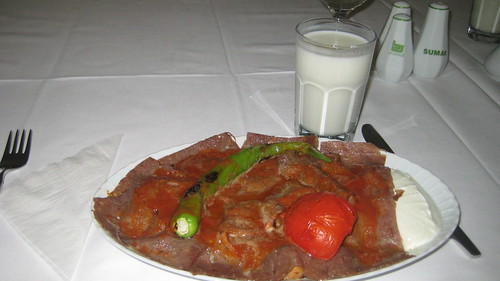
Pictured: Künefe topped with kaymak
For dinner we went out for İskender Kebabı at Ankara’s famous Uludağ Kebapcısı. There are many different varieties of kebap, but İskender is perhaps the most famous within Turkey. It features a layer of thinly shaved meat from a rotating block similar to a gyro. It’s also called döner which means spinning in Turkish. The meat is placed on top of crusty, spongy Turkish pita and served with a large spoonful of thick yogurt on the side. After the plates of meat are delivered to the table, the servers bring out a pot of tomato sauce followed by a pot of sizzling butter that they ladle on top. Traditionally this dish is served with a roasted tomato and long, green pepper and a large glass of a thick yogurt drink called ayran. Each slice of meat was well browned and juicy and the pita underneath soaks up the meat juices. You can order as many portions as you want (including half portions). I went for a single portion because I wasn’t really hungry after that huge brunch earlier in the day, but in the past I’ve eaten 2.5-3 portions no problem. For dessert we ordered künefe which is made with shredded wheat on top of a soft cheese covered in a light syrup. Künefe is served hot so the cheese is gooey and topped with either ice cream or clotted cream (called kaymak). This particular version was nice and crispy on top though the syrup was surprisingly thin. Regardless, this is an incredible dessert that you have to try when you’re in Turkey.
http://www.uludagkebap.com.tr/english/index.htmLast edited by turkob on February 1st, 2011, 10:06 pm, edited 1 time in total.
-
-
Post #5 - September 19th, 2010, 10:41 pmPlease keep the reports and pics coming. Turkey is on my list of places to visit and dine.“Nothing is more agreeable to look at than a gourmande in full battle dress.”
Jean-Antheleme Brillat-Savarin (1755-1826)
-
-
Post #6 - September 20th, 2010, 4:19 amNice report. I have no experience with Turkish foods other than the Doner Kabob which is the #1 street food in Germany. Very tasty, too.
-
-
Post #7 - September 20th, 2010, 7:41 amfantastic report. enjoy ankara - there is exceptional food in ankara, and not that many tourists get there. by the way, try to get to the archeological museum if you can.
-
-
Post #8 - September 20th, 2010, 7:48 amI agree, please keep posting these great food stories. It's been (gulp) 34 years since I visited Turkey and I've wanted to go back ever since.
One thing I vividly remember about Istanbul were street vendors everywhere selling a yogurt drink. Do those still exist?"The only thing I have to eat is Yoo-hoo and Cocoa puffs so if you want anything else, you have to bring it with you."
-
-
Post #9 - September 20th, 2010, 10:23 amI spent some time in Istanbul, eating just about everything I could get my hands on. I can't wait to see your photos from that city."To get long" meant to make do, to make well of whatever we had; it was about having a long view, which was endurance, and a long heart, which was hope.
- Fae Myenne Ng, Bone
-
-
Post #10 - September 20th, 2010, 3:54 pmWhat a lovely memory journey turkob--tnx sooo much for taking us along with you.
There was a recent New Yorker article describing a similar journey. Now you're more than re-inforcing our desires to somehow get to Türkiye, and SOON!
GeoSooo, you like wine and are looking for something good to read? Maybe *this* will do the trick!
-
-
Post #11 - September 20th, 2010, 11:25 pmI'm so glad people are enjoying my posts about Turkish food. It truly is a wonderful food culture and I'm proud to share it.
Pictured: Manzara at D&R Bookstore
I told my aunt after almost two days of heavy eating I had forgotten what it felt like to be hungry. She said, then we must drink some Turkish coffee to help you digest so we can eat more! We took a trip to a bookstore called D&R which is very similar to a Border's. It's five stories with a cafe on the sidewalk in front and one on the fifth floor. After I picked up a couple Turkish cookbooks, we went out to the sidewalk cafe, but my aunt immediately started shaking her head. There's no manzara, she said and grabbed me by the arm and took me up to the top floor. Turks have a very healthy obsession with beautiful views. People are sitting out on their balconies at every possible moment to enjoy the manzara. Without a proper manzara, she told me, my coffee just wouldn't taste right.
Pictured: Turkish kahve
The bookstore cafe was a very non-traditional Gloria Jean's coffee, and admittedly the coffee itself was thinner than homemade. I hope to have better cups of kahve on the trip, but the experience of enjoying a manzara while sipping a Turkish coffee was as authentic as it gets.
Pictured: Inverted coffee, preparing for fal
Pictured: My fortune. You will never feel hunger again
After I finished I asked my aunt if she could tell my fortune (kahve falı). She scoffed at the suggestion. Coffee fortunes are for old ladies she told me. Nonetheless she turned my cup upside down and told me to let it cool before we took a look. After about five minutes the grounds had settled on the saucer and she started eyeing my cup. Here's what she saw. The large blob at the bottom of the cup looks like Canada, so I will be taking a trip there soon. There are very few streaks so I have a clear conscience. At the very top of the picture looks like a fish, which means good luck. Then she laughed, she said no matter what your cup looks like, you can find a fish.
Pictured: Cacik
For lunch we ate some of the leftovers from the previous day along with a salad and a cold soup called cacik (pronounced juh-jik). Home-cooked Turkish meals almost always include yogurt and cut up vegetables, tomatoes, cucumbers and green peppers (the smaller green ones) being the most common. The classic Turkish salad combines these veggies with some red onions and green leaf lettuce tossed with lemon juice and olive oil. Cacik is simply yogurt and cucumber with salt, very refreshing. It's also well known that olive oil dishes that are served cold actually taste better after a day or two. The stuffed grape leaves, which were already great on Sunday, developed an even deeper flavor in the fridge.
Zeynel Çilli
Pictured: Sakızlı Muhallebi and Tavuk Göğsü Kazandibi
That afternoon my aunt insisted we see all the new malls that have been built in Ankara the past couple years. After looking around at all the stores (man, prices for American products are much higher in Turkey), we stopped by the food court. It was cool to see so many Turkish fast food options like pide, köfte, döner, lahmacun and tantuni (I plan to eat all those foods at some point) standing next to American standbys like Burger King, KFC and Pizza Hut. We stopped by Zeynel Çilli for an afternoon snack. At first I was hesitant because I didn't want to bother eating lousy foodcourt food, but my cousins insisted that Zeynel puts out great versions of Turkish puddings. So we got an order of mastic flavored pudding (sakızlı muhallebi) and caramelized chicken breast pudding (tavuk göğsü kazandibi) to share. Mastic has a very unique flavor that I love, but it's certainly not for everyone. In Turkey it's commonly seen as a gum flavor (in fact the word for gum is sakız) as well as in desserts. The shredded chicken breast gives the kazandibi a very unique, stringy and spongy texture that I really like. The flavor of the chicken is very mild, so don't be afraid to try it if you ever get the chance. Kazandibi means the bottom of the pot, where traditionally they would burn the bottom of the pudding. Anymore, Turks brown the top of kazandibi puddings in the oven. The caramelization brings a lot of depth to the dessert as well as a nice crust. I have to say I was surprised to have such great examples of these desserts in a food court, but these were damn good.
http://www.zeynelcilli.com/menu.php
Pictured: Patlican and patlican salatası

For dinner we invited over the entire family to help finish off the copious leftovers. To round out the meal my aunt threw together an eggplant salad (patlican salatası). First she cooked the eggplant directly on the stove top to give it a nice smokey flavor (critical in middle eastern eggplant salads) then she mixed it with yogurt, lemon juice, olive oil and lots of garlic. This couldn't be easier to make and it was absolutely delicious with a nice warm piece of spongy Turkish pita.
Pictured: Rakı, the national drink of Turkey

My uncle busted out an ice cold bottle of rakı (pronounced ruk-uh) and asked me if I'd like to try. I laughed since I've had rakı many times before. It's an anise flavored liquor (strong too, 90 proof) that's very similar to ouzo. Honestly, I think they may be identical, though no Turk nor Greek would agree to such blasphemy. Rakı is excellent alongside meze and lamb dishes, but most famously it is served with fresh fish. My father always complains when he orders fish at a restaurant and he can't have a glass of rakı to wash it down. Traditionally it is served in a tall, thin cylindrical glass with water on the side. The rakı is poured into the tall glass then water is added to taste. When water is added the clear liquid turns cloudy. It is best served ice cold. It's an acquired taste to be sure, but no trip to Turkey is complete with enjoying a glass of rakı while eating fresh fish on the waterfront (with an excellent manzara, of course). I don't need a cup of kahve to know that such an experience is in my future.
-
-
Post #12 - September 21st, 2010, 7:16 amThis thread makes me wish Nazarlik was still open...
I had both Çiğ köfte and the chicken breast pudding there. The kofte was great, but the chicken breast pudding wasn't quite right, according to my Turkish friend. What were your impressions of it?
Anyhow, please keep posting. Turkish food is one of the world's greatest cuisines, and under-appreciated over here, methinks.
-
-
Post #13 - September 28th, 2010, 12:54 ammtgl wrote:This thread makes me wish Nazarlik was still open...
I had both Çiğ köfte and the chicken breast pudding there. The kofte was great, but the chicken breast pudding wasn't quite right, according to my Turkish friend. What were your impressions of it?
Anyhow, please keep posting. Turkish food is one of the world's greatest cuisines, and under-appreciated over here, methinks.
Chicken breast pudding is one of my favorites. I think it lends the dessert a thick and spongy texture that matches the rich, milky flavor well. I also loved Çiğ köfte, though I'd never had it before this trip. The example I had was well spiced and served with lettuce and tomato that balanced it out. I'll post about it soon.
-
-
Post #14 - October 25th, 2010, 11:36 amSorry for the long delay. After I left my aunt's house in Ankara internet was very spotty the rest of the way.
Pictured: View of Anıtkabir (Ataturk's Mausoleum)
First a couple notes on typical Turkish meals.
Pictured: Mandarin oranges (mandalina)
Fresh fruit is a big part of the Turkish diet. Most restaurants offer a plate of fresh fruit as an after dinner course. Common fruits include figs, pomegranates, grapes, melons and mandarin oranges. I was surprised to see that they serve the oranges when they're still green. The flesh is closer to yellow than the orange we're used to see in the states and the flavor is less sweet.
Pictured: Black tea (çay)
Another big part of Turkish culture is tea. Pretty much any time people are sitting around talking, tea will be served. This includes at breakfast, after meals, with afternoon snacks and even when shopping in smaller stores. I knew Turks drank a lot of tea, but I was surprised by the frequency with which I was offered it. I spent a couple hours hanging out at my aunt's pharmacy and many people would stop by to chat, pick up a couple items, and enjoy a cup of tea. At the bazaars there was always a tea stand that would brew up fresh cups and deliver it to the different shop owners and their patrons. In tourist areas, apple tea will be offered to those not accustomed to the constant rush of caffeine, but outside of the tourist areas when you say tea it means black tea.
Pictured: Mantı
I was very lucky to get a chance to try some homemade mantı while I was in Ankara. Mantı is simply ground meat wrapped in dough and boiled, very similar to ravioli. It's time consuming to make, but the results are worth every minute of effort. Mantı is traditionally served with garlic yogurt (lots of garlic) and can be topped with tomato sauce though when I make it at home I eat it without the sauce.Last edited by turkob on October 25th, 2010, 3:21 pm, edited 1 time in total.
-
-
Post #15 - October 25th, 2010, 1:54 pmYea! you're posting again, I was waiting with baited breath for the next installment.For what we choose is what we are. He should not miss this second opportunity to re-create himself with food. Jim Crace "The Devil's Larder"
-
-
Post #16 - October 25th, 2010, 2:14 pmI thought the tea was a ploy to get tourists to stay and buy (or feel bad if you didn't). A cultural thing I guess. @ least the guilt and how we project. One day we went out to the suburbs of Istanbul to a cymbal factory I was interested in. The Zildjian family, cymbal makers to the Ottoman Empire did well in Turkey for a few centuries. They had to leave (open season on Armenians) but the factories and artisans remained. Spent quite a bit and didn't feel bad about drinking the tea pretty much non stop for a few hrs while my girlfriend and sister indulged me. I'm looking @ that cymbal right now. Amazing tone and voice."In pursuit of joys untasted"
from Giuseppe Verdi's La Traviata
-
-
Post #17 - October 25th, 2010, 3:04 pmMy last day in Ankara, we took a day trip to Beypazarı. For tourists, Beypazarı is best known for its Ottoman architecture.
Pictured: Beypazarı
But the locals know it best for its many, many culinary specialties. They are perhaps best known for their carrots and mineral water. All over Turkey you can buy Beypazarı brand mineral water that is bottled just outside town. We stopped by to pick up a case before we left town. Beypazarı also grows over half of the carrots grown in Turkey. They even have a statue of a carrot in the middle of town.
Pictured: Beypazarı's famous carrot
All over the market vendors sell fresh squeezed carrot juice and carrot kebabs which are basically carrot flavored Turkish delight. They also sell carrot flavored ice cream, though I didn't try any.
Pictured: Beypazarı Kurusu
Our first stop of the day was to pick up a couple large bags of Beypazarı kurusu. They are dry, salty biscuits that snap when you bite into them. The original kurusu shop is in the middle of town and they give out samples by the handful.
Pictured: Erişte
Next stop was to pick up some erişte and tarhana. Erişte are hand made egg noodles that are typically used in soups. Tarhana is a powder made of fermented yogurt and wheat that is used to make a soup of the same name. Both were sold at stands all over town. I quickly realized that my aunt loves food as much as I do, since this day revolved primarily around picking up lots of different food items. Beypazarı is a food lover's dream town since such a huge part of the economy revolves around local specialties sold at the market in town.
Tarihi Taş Mektep
Pictured: Saç Kavurma
Pictured: Lamb Güveç
For lunch we stopped at a restaurant specializing in local cuisine called Tarihi Taş Mektep. The meal started with an order of ground beef stuffed grape leaves (yaprak sarması dolma). Typically these dolmas are about the size of a fat cigar, but the local custom is to make them small and thin, more like cigarettes, to highlight the flavor of the leaves. Dolmas are traditionally served with yogurt, and in this case the yogurt was very thick and creamy. Next up was the lamb saç kavurma. Saç refers to the thin metal pan that this dish is prepared on. The thin pan gets very hot so the meat is well browned. Last up was güveç which is a casserole made with lamb and rice and cooked in clay bowls. All the güveç orders came out at once on a huge tray. The rice really soaked up the rich lamb flavor and the crust at the bottom (as usual) was the best part. For dessert we tried another local specialty, 80 layer baklava. Usually baklava is made with 40 layers of phyllo dough, but in Beypazarı they make the dough extra thin and stack 80 layers. Unfortunately, while the main courses were delicious, the baklava tasted rancid, so I can't tell you what difference the 80 layers makes.
On the way back we stopped by a couple farm stands where local farmers sell to people who are driving to Ankara on the highway. Like I said, every minute of this excursion revolved around buying food. I tried some of the tomatoes the next morning for breakfast, and I have to say they were spectacular.
Next stop, İzmir!Last edited by turkob on February 1st, 2011, 10:15 pm, edited 3 times in total.
-
-
Post #18 - November 9th, 2010, 11:00 amBefore I move on to İzmir, I have to give one last shout out to the incredible hospitality and excellent taste of my aunt and uncle in Ankara. Before taking me to the airport, my uncle insisted I try one more of his favorite foods. How could I resist.
Pictured: Lokma

Lokma is the Turkish version of a doughnut. It’s made from very wet dough that is spooned into frying oil then soaked in thin, lightly sweet syrup and served warm. The outside is a little crunchy and the inside is gooey. When warm, these little balls soak up just enough syrup to provide a small burst of sweetness with every bite. What an awesome way to say goodbye to Ankara.
Ankara is a very large city (over 4 million people) with plenty of excellent dining options no doubt. While I didn’t get a chance to sample much of the restaurant scene because my family in Ankara enjoys cooking so much, there are no doubt lots of great dining options in the city. Here’s a useful blog I found that can guide someone looking to dine well in Ankara.Last edited by turkob on November 10th, 2010, 2:47 pm, edited 1 time in total.
-
-
Post #19 - November 9th, 2010, 11:28 amThe next leg of my trip was in İzmir. I also have family in İzmir, but since I had some friends from the states join me there, I ended up eating out most of the time. Both of my parents were born and raised in İzmir, so I have roots there.
İzmir
İzmir is the third largest city in Turkey and was also known as Smyrna through history. It’s located on the Aegean coast and uses the waterfront very well. The weather in İzmir is very mild so most dining is done outdoors, with a view of the Aegean a must. There is a two mile stretch of restaurants and bars right next to the water that is busy every night. There is very little tourist traffic because İzmir lacks top end attractions, but I can’t recommend it highly enough as a place to get an authentic Turkish experience.
İzmir is perhaps most famous for its seafood restaurants. I went to four different seafood restaurants during my stay in İzmir and I have to say all were excellent. Since the experiences between the restaurants were so similar, I thought I’d write about them together.
Pictured: Fish counter
The visit to a balık (fish) restaurant begins before you even sit down. The first stop is at the fish counter. There you choose the fish you want to eat and how you want it prepared. It’s priced by the pound, but there’s no price written anywhere so either you accept what they’re charging, or you bargain, depending on how nice the restaurant is. The classic Mediterranean preparation is to grill the fish with olive oil (charred skin!), but you can also get it breaded and fried, grilled on skewers or baked in salt.
Pictured: Meze counter
Pictured: Midye Dolmalar
The next stop is at the meze counter. Some restaurants show you their meze options on a large tray, others on a cart, but my favorite are the restaurants where the meze are displayed in a refrigerated case. Either way, you get to choose a handful of cold vegetable or seafood dishes to start the meal. There are too many to list here but some of my favorites are the mussels stuffed with rice (midye dolması), roasted eggplant salad (patlıcan salatası) and what wikipedia tells me are called samphire (deniz börülcesi). Note that the stuffed mussels are a very common street food in Turkey. My family warned me not to eat the ones off the street, but we tried a couple and they were fine. Nonetheless, if you want to try this specialty without risking it on the street, a seafood restaurant is the answer.
Pictured: Rakı in an iced container
Once everyone is seated, the meal begins with rakı service. The new trend is rakı made from fresh grapes (yaş üzüm) whereas traditionally rakı is made from raisins. Rakı bottles come in many different sizes. The two premium labels (that are sold in restaurants for only 15-20 lira more than the standard brands) are Kara Efe and Altın Baş. These are barrel aged in addition to being made from fresh grapes. Once the rakı is brought to the table, the server pours the clear liquor into everyone’s glass. Most people take it duble which is essentially a double shot, though you can drink it as strong or as weak as you want (straight up it’s 90-100 proof). Then the glass is filled to about 2/3 full with water and the drink turns a milky white color. Finally a bucket of ice is brought out and 1-2 ice cubes are added. There are also specific rakı cozies (pictured above) that keep the rakı ice cold without the need to water the drink down further, but this is hardly standard.
Pictured: Patlıcan Kızartması
After the rakı is served, the cold meze are brought to the table along with a plate of cut up lemons for squeezing on everything. This usually includes a Turkish salad, olives, green melon and feta cheese as well. As people are enjoying the first course, the next course of hot meze is ordered. This usually consists of either fried (tava) or grilled (ızgara) octopus or calamari or fried eggplant served with tomato sauce and garlic yogurt (patlıcan kızartması).
Pictured: Salt Baked Levrek (Sea Bass)
Pictured: Fried Barbun (Red Mullet)
Pictured: Dil Şiş (Sole kebab)
Pictured: Çıpura (Sea Bream)
Pictured: Kelle
Then the star of the show arrives. The fish is, of course, incredibly fresh. When you order the whole grilled fish, it comes with the head on (kelle) that is plated and given to the head of the table. Eating the fish head is an honor at a Turkish dinner table, and don’t be afraid to get messy. Also most plates include some bitter greens to munch on between bites of delicate fish.
After dinner, tea and coffee are served along with a large plate of fresh fruit and possibly a couple small desserts. Typically the desserts will be fruit based such as candied figs with walnuts or pumpkin in syrup (kabak tatlısı).
As I said, this experience was nearly identical at the four seafood restaurants I visited in İzmir. Deniz Restaurant and Veli Usta’s Balık Pişircisi are both on the Kordon waterfront. Deniz is a little more high end, but both are excellent. Deniz Bostanlı Restaurant is in the Bostanlı neighborhood which is next to Karşıyaka on the opposite side of the bay from downtown. And Gözde Balık Restaurant is in the coastal town of Ilıca. Every one of these restaurants was full when I went, so I highly recommend getting reservations, particularly if you’d like to sit outdoors.
Deniz Restaurant
http://www.denizrestaurant.com.tr/index_ing.html
Balık Pişircisi Veli Usta
http://www.izmirbalikpisiricisi.com/index.php
Deniz Bostanlı Restaurant
http://www.denizbostanli.com/
Gözde Balık Restaurant
http://cesmegozdebalikrestaurant.com/?sayfa=0
-
-
Post #20 - November 9th, 2010, 1:07 pmNot sure how I missed this thread as it developed, but now that I've read it, I just want to add my voice to the chorus.
Excellent stuff, turkob. Thanks very much for all of these great posts about your trip.
--RichI don't know what you think about dinner, but there must be a relation between the breakfast and the happiness. --Cemal Süreyya
-
-
Post #21 - November 10th, 2010, 4:50 pmA great place for quick, cheap food in İzmir is the Kermaltı bazaar. It’s similar to Istanbul’s Grand Bazaar, but smaller.
Kermaltı
Pictured: Çağ Kebabı

Near the the kızlarağsı han entrance to the bazaar is a shop that serves çağ (pronounced chaw) kebabı, a specialty from Erzurum province. It is similar to döner kebabı in that it is thin stacks of meat pressed together and rotated on a spit, but that’s where the similarities end. Çağ kebabı is rotated horizontally in front of a wood burning fire so that the meat gets crispier and it’s cut into small strips rather than wider leaf-like pieces. Also, çağ kebabı is made from exclusively lamb meat and tail fat whereas döner kebabı usually is a mix of beef and lamb (and tail fat at a good shop). This awesome kebab is much harder to find than the ubiquitous döner stands, but it’s worth seeking out. The crispy pieces of lamb taste incredible with a tall glass of cold ayran.
Pictured: Kaşarlı Pide
There are lots of pide and lahmacun store fronts throughout Turkey. The key is to find one where the dough is rolled out after you order and it’s baked in a wood-burning oven. Pide and lahmacun (pronounce lah-mah-joon) are made from the same dough but lahmacun is circular like a pizza while pide is long and thin and the dough is rolled out thicker. Pide is usually topped with either feta (beyaz peyniri) or kashkaval cheese (kaşar peyniri) and egg, sucuk (sausage) or pastırma. Lahmacun is usually topped with a mixture of tomatoes, onions, ground beef and ground lamb. The dough is thin so it is crispy, yet soft enough to roll like a burrito. Lahmacun is topped with onions, lettuce, parsley and lots of sumac, spritzed with lemon then rolled up and eaten by hand. The lahmacun and pide we had in Kermaltı were the best I had the entire trip.
Pictured: Tavla ve kahve
No trip to Kermaltı would be complete without a cup of strong Turkish coffee and a game of backgammon (tavla). There are coffee shops all over the bazaar with lots of comfortable seating and plenty of backgammon boards. The favorite past-time of Turks is to sit around and smoke a water-pipe (nargileh) while sipping coffee or tea and playing backgammon. While I was in İzmir and İstanbul with friends, we probably spent an average of 1-2 hours a day playing backgammon and sipping caffeinated drinks out of little cups. There are outdoor cafes all over town specializing in this pursuit.
-
-
Post #22 - November 11th, 2010, 4:54 pmOne night we visited my uncle who lives in the Karşıyaka neighborhood of İzmir. That translates in English to "opposite shore." It's a 15 minute ferry ride from the boat terminal at Alsancak to get there, and it's well worth the trip if for no other reason than to roam the streets of the bustling commercial area. And of course, to sample some excellent (and interesting) street food.
Pictured: Çiğköfte and İçliköfte
Çiğköfte (pronounced chee-kofteh) is something you see a lot on the street in İzmir and İstanbul. It translates literally to raw meat ball and it's a mixture of raw ground beef (sometimes lamb) with bulgur and lots of spices. This is another food I was warned to avoid eating on the streets because of the risk of food borne illness. You can order it in some restaurants, and I think as a rule of thumb if there's a line of people in front of a çiğköfte stand, it's probably safe. Nonetheless, I lucked out because my uncle directed us to a reputable stand. This stand is across the street from the Kemalpaşa mosque and it had a long line of people in front of it. The meatball is formed by hand and served as a lettuce roll with lots of lemon to squeeze on top. The meat is very assertively spiced with a distinct chili (almost fruity) pepper flavor. Anymore, stands have started serving vegetarian versions of this dish (not sure what's it's made of) that share the same spicing profile but lack the texture and robustness of the ground meat. Still, if you'd like to try çiğköfte and don't want to risk eating raw meat from a street vendor, the vegetarian versions are a pretty close approximation.
İçliköfte (pronounced itch-lee-kofteh) can also be found at stands around town, but it's much less common than çiğköfte. The outside shell is made of bulgur wheat and fried so that's it's crispy but not greasy. Inside is cooked ground beef with walnuts and some spices, though much less spicy than çiğköfte.
Pictured: Ayran
Next door to the köfte stand is a shop that sells börek and ayran. This contraption aerates the ayran (drink made of yogurt, water and salt) so it has an almost carbonated mouthfeel to it. Fresh ayran off the street was the perfect balance to the spicy raw beef.
Pictured: Kelle (sheep's head)
On the other side of the market is a shop that specializes in roasted sheep's head (kelle). After the head is ordered, it is taken behind the counter and chopped into lots of small chunks and the bones and teeth are removed. Piled high on the plate is a mass of rich lamb meat including brains, tongue, and eyes. I'm a lover of all things offal, and I absolutely loved this dish, but it's definitely not for the faint of heart.
Pictured: Turşu Suyu
Served with the sheep's head were pickled peppers and a nice cold glass of pickle juice (turşu suyu). The sourness was a much needed counterbalance to the richness of the lamb meat. Turkish pickles are more sour than western pickles with almost no discernible sweetness.
Koko King
Pictured: Kokoreç (not from Koko King)
Pictured: Kokoreç sandwich
Pictured: Uykuluk sandwich (sweetbreads)
Perhaps our favorite streetfood of the trip was a small storefront in the Alsancak neighborhood (not in Karşıyaka) called Koko King. Their specialty is the late night alternative to döner kebabı called kokoreç (pronounced koko-rech). Kokoreç is a log of ground sheep organs wrapped in sheep intestines and roasted on a horizontal spit like çağ kebabı. It's sliced in thin strips and served on toasted, spongy bread. It's an incredible, greasy, gamey, spicy post-bar treat. The meat is seasoned with oregano and lemon juice and some hot peppers. There are lots of kokoreç shops around town, but Koko King stood out because they use coals, make sure to get the meat nice and crispy before serving it up, and the bread was fresh even at 1 in the morning. They also serve a very spicy grilled sweetbreads sandwich (uykuluk). When I told the store owner that we usually eat sweetbreads at nice restaurants in the US, he laughed because in Turkey sweetbreads are eaten as a cheap street food. Koko King closes at 2AM, so we ended up there a couple times during our stay in İzmir. Note that they're closed on Sundays, which we found out the hard way.
Koko King
1453 Sokak No:4/A
Alsancak / İzmirLast edited by turkob on November 14th, 2010, 6:20 pm, edited 1 time in total.
-
-
Post #23 - November 12th, 2010, 10:34 amOh man, I did not need to read this right before lunch. We can't wait to get back to Turkey and see the countryside.
Suprised you haven't mentioned sütlaç yet. Is that more of an Istambul thing?
-
-
Post #24 - November 12th, 2010, 1:06 pmActually, I didn't have any sütlaç on my trip. I like sakız flavored pudding/ice cream and kazandibi so much that any time we were in a milk dessert shop, I ordered that.
-
-
Post #25 - November 19th, 2010, 10:33 amNow to talk about the various kebab restaurants in İzmir.
Halim Usta Altın Nazar Kebap ve Pide Salonu
Pictured: Mardin Kebabı
The word usta means master (as in master of a craft) in Turkish, and you'll commonly see restaurants named after their owner use this term. So in this case this restaurant is run by Halim the master. It's located in Karşıyaka, a short walk from the boat terminal. They specialize in extra thin lahmacun and a harder to find kebab called Mardin Kebabı (named after the Turkish city of Mardin). Mardin Kebabı is a type of köfte made with lots of herbs and chunks of onion. The meat is somewhat crumbly, but the grilled flavor accents the herbs and onions very nicely.
Halim Usta Altın Nazar Kebap ve Pide Salonu
1720 Sok. No:14/A
Karşıyaka, İzmir
Köfteci Remzi
Pictured: Kaşarlı Köfte
We accidentally discovered Köfteci Remzi after learning that Koko King is closed on Sundays. We were starving after an exciting soccer game at Alsancak stadium (kaf kaf kaf, sin sin sin, kaf sin kaf sin kaf!), so we went looking for some street food. To our surprise, many of the street food stalls were closing up around 10PM, so we decided to do a sit down meal at the 24-hour köfte shop in the heart of Alsancak. They specialize in different ground meat preparations so we tried a couple. I had never seen cheese stuffed köfte before, but it was a very pleasant surprise. The meat was a rich mixture of ground beef and spices with salty, melted kashkeval cheese in the middle like an inside-out cheeseburger. I didn't see this item on any other menu on the trip, so I guess Remzi is the place to get it. We also ordered the easier to find Adana kebabı which is named after the Turkish city Adana. Adana kebabı is known as the spiciest köfte dish and this version was nice and hot (definitely needed the ayran to balance it out). Adana kebabı is typically made with a mixture of ground lamb, ground beef and tail fat with lots of red pepper (pul biber) giving the kebab a distinct reddish color. Not bad for a 24-hour sit down joint in the middle of the main square.
http://www.kofteciremzi.com.tr/index.htm
Boğaziçi Ocakbaşı
Pictured: Arnavut Ciğeri (stock footage)
Pictured: Mixed grill with Beyti Kebabı
Boğaziçi is the Turkish name for the area around the Bosporus Strait in Istanbul and ocakbaşı means grill. It's located in Bostanlı, next to Karşıyaka. They have a wide array of different kebabs on the menu. I particularly enjoyed their version of Arnavut Ciğeri which means Albanian liver. In this preparation, the liver is cut into large cubes and seasoned with cumin, sumak and hot peppers. The rendition at Boğaziçi was very tender and had a mild liver flavor that carried the spices well. We also ordered the mixed grill which included a couple different beyti kebabs which are kebabs wrapped in durum. This is a top quality kebab restaurant, I highly recommend it.
http://www.bogazicirestaurant.com.tr/
Antepli Ramazan Usta
Pictured: Fındık Lahmacun
Pictured: Alinazik Kebabı
Antepli Ramazan Usta specializes in foods from the Gaziantep region of Turkey. They're located in Bornova near Ege University. It's a fun neighborhood with lots of bars and cafes catering to the student population, and of course, great cheap eats. We started the meal with a couple fındık lahmacuns which are just smaller. These were particularly crispy with lots of herbs. Then we ordered a couple kebabs. The best of the bunch was the Alinazik kebab which is a kebab on a bed of smoked, pureed eggplant and topped with tomato sauce. The eggplant was mixed with yogurt and garlic so it was creamy and smokey. I couldn't believe how well meat and eggplant went together in this dish, just incredible. It's kind of out of the way, but it was well worth the trip.
http://www.ramazanusta.com/
-
-
Post #26 - November 19th, 2010, 4:18 pmPictured: Library of Celsus, Ephesus

One day we rented a car and took a trip down to Ephesus to see the famous ruins. It’s only an hour drive from İzmir and the roads are well paved making for an easy trip.
Selçuk Köftecisi
Pictured: Zeytin Yağlı Pırasa (leeks in olive oil)
Pictured: Çöp Şiş
The region is famous for çöp şiş which is a kebab made with small pieces of skewered lamb meat cooked over coals. My family recommended we have çöp şiş at Yandim Çavuş but unfortunately it was closed. As I was writing this post I couldn’t remember the name of the restaurant and I googled around but couldn’t find it. Then I tried searching for çöp şiş Selçuk (the city where Ephesus is located) on google Turkey and it was the first hit, probably a good sign. Nonetheless, we ended up at a pretty good alternative, Selçuk Köftecisi. Like the fish restaurants described earlier, Selçuk Köftecisi has a display case with their meze offerings of the day. We picked up a serving of the eggplant salad and possibly my favorite of the olive oil vegetables, zeytin yağlı pırasa (leeks). The best part of those dishes is soaking up the flavored olive oil from the plate with fresh, spongy bread. Seriously, we could have just eaten meze there and been happy. After the meze we had an order of köfte patties (as opposed to long and flat or log shaped like at other places) and the çöp şiş that were both well seasoned and moist. We were pretty happy to enjoy such a delicious and cheap meal so close to such a major tourist attraction.
Selçuk Köftecisi
Şehabettin Dede Cad. No: 8
Selçuk Merkez, Selçuk, İzmir
-
-
Post #27 - November 19th, 2010, 4:20 pmSevinç Pastanesi
Pictured: Baklava, four ways
After all that grilled fish and kebabs, it's hard to believe we had any room left for dessert. But after one bite of the flaky baklava at Sevinç Pastanesi, there was plenty of room to be found. It's located in the middle of the main square in Alsancak with plenty of outdoor seating for people watching and taking in the warm Aegean air. They make just about everything including French-style cakes and pastries, Turkish baklavas and kadayifs, Turkish milk desserts, and all sorts of cookies and chocolates. The main dining room is pretty elegant, and the prices are a little steep, but the quality is undeniable. I had probably the best cup of Turkish coffee I had on the trip next to a mixed plate of baklavas. Everything was top quality, I was sorry I didn't have time to sample more.
http://www.sevincpastanesi.com/
Bolulu Hasan Usta Süt Tatlılar
Pictured: My uncle's creation
Hasan Usta is a major chain located all throughout Turkey. As their name would suggest, they specialize in milk desserts (süt tatlılar) like sütlaç, kazandibi, muhallebi, and ice cream (dondurma). Honestly, the quality of the desserts was good but not great, but we did have a memorable experience there with my uncle. As we were finishing up a huge meal with the family and my friends, he asked us if we were hungry for dessert. We all told him that we couldn't eat another bite, and we really couldn’t. He looked at us and said “I thought you guys said you were big eaters.” He suggested that we try a small dessert from the shop across the street. We tried to resist, but he insisted that it was his favorite and that it was just a small bite. We foolishly submitted to his trickery and walked across the street. As he was ordering in Turkish, I realized that he had set a trap for us, but I decided not to ruin the surprise for my friends. He ordered a dessert the clerk called the “bomba” that consisted of a layer of bread soaked in syrup (ekmek kadayıfi), topped with a layer of kazandibi, topped with a scoop of blackberry ice cream. One for each of us. When the plates came out my friends moaned loudly, this was hardly a small dessert. My uncle responded, “in America, they would call this small.”
http://www.bhu.com.tr/source.cms.docs/b ... r/bhu.html
Yeşil Ev, Kahvaltı Bahçesi
Pictured: Çiğ Börek
My last day in İzmir, my family took us up to Foça for a country breakfast. Apparently this region is famous for their breakfast houses since we passed probably 6-7 on the road. Yeşil Ev, Kahvaltı Bahçesi translates to Green House, Breakfast Garden, and the name was very accurate. The tables are setup on a lush, green lawn with patio furniture and umbrellas. All the food is locally sourced including Turkish breakfast standards like jellies, olives, cheeses, clotted cream with honey, sucuk with eggs and gözleme. The house specialty is the çiğ (raw) börek. It is made from a simple dough that is rolled out thin, stuffed with raw ground beef (hence raw), then pan fried until the outside is crispy and the beef is cooked. It’s always been a favorite of mine.
http://yesil-ev.com/
Before I leave İzmir, I have to mention the wonderful olive oil dishes my aunt made for us. She was sad she couldn’t cook for us because our schedule was so hectic so she prepared a couple cold dishes that we could eat when we were looking for a snack.
Pictured: Zeytin Yağlı Enginar (artichokes in olive oil)
Pictured Zeytin Yağlı Kabak (zucchini in olive oil)
Both are very traditional preparations that show how the recipes vary to match the flavor profile the vegetable. Artichokes are frequently served stuffed like a dolma rather than cut up like this, but either way they are usually paired with carrots and onions (and sometimes peas too). Zucchini on the other hand are prepared more simply with just tomatoes and onions. As is typical for these types of dishes, they develop flavor very well in the refrigerator and peak a couple days after they’re made.
Next stop is İstanbul.
-
-
Post #28 - January 27th, 2011, 1:50 pmI posted about İstanbul in the İstanbul thread.
-
-
Post #29 - January 27th, 2011, 1:55 pmFrom İstanbul, my wife and I headed down to Antalya which is on the southern coast of Turkey. It's an area famous for its ancient Greek ruins and miles of beaches. It's mostly a tourist destination, but Antalya itself is a city with a population of close to 800,000 people so there are some good eating options if you get away from the tourist district.
Pictured: Olympos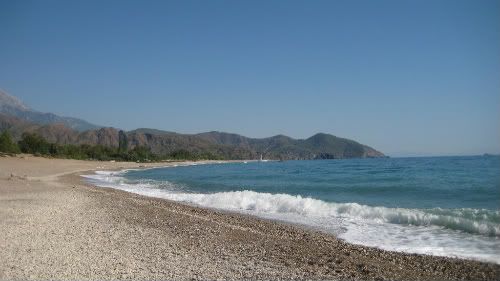
Our first day we rented a car and drove down the coast to the ruins at Olympos. Right before the turn off the highway is a little shop specializing in Turkish meatballs, köfte.
Akhisar Köftecisi
Pictured: pide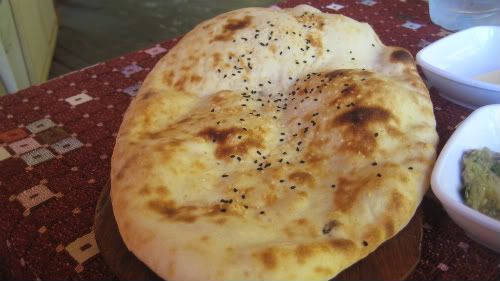
Pictured: İnegöl köftesi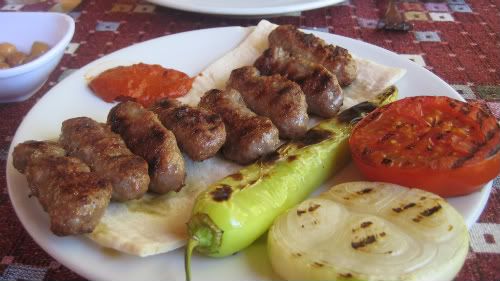
İnegöl köfte are very spongy lamb meatballs that almost pop when you bite into them. They're made with a little baking soda to give them the unique texture. This was nice a spot for a quick bite on the well-traveled highway between Olympos and Antalya.
http://www.ulupinarakhisarkoftecisi.com/tr/default.asp
Pictured: Amphitheater at Aspendos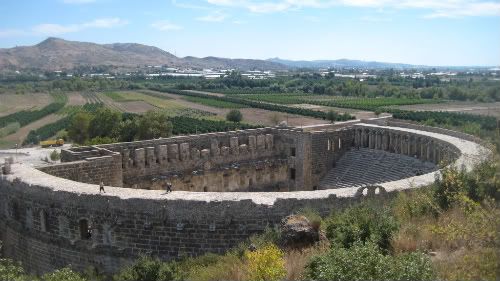
Pictured: Süt Mısır
All along the road between Antalya and the famous ruins at Termessos and Perge are huts that sell süt mısır, which is boiled corn on the cob. Not memorably good corn or anything, but a very authentic experience and a good treat between hikes at the ruins.
Antalya Balık Evi
It's a beautiful 20 minute taxi ride from Kaleiçi (old town) down the coastline to the Lara part of Antalya. It's famous for its upscale hotels and mansions, so naturally I'd expect them to have a great fish restaurant. The experience at Antalya Fish House was very similar to the places I described in İzmir. And just like in İzmir, reservations are necessary, this place was packed on a Wednesday night in October (the tail end of tourist season).
The meal begins with a trip to the fish counter to pick out what's fresh and how you'd like it prepared. From there you head to your table and order a bottle of rakı and pick meze from the meze cart.
Pictured: olive oil celery root, fava bean spread, yogurt with watercress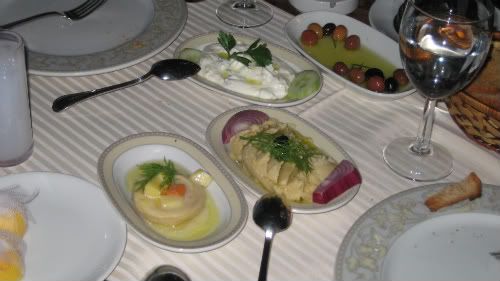
The crunchy olives were the highlight, but all the meze were solid. Next up is the hot appetizers.
Pictured: Grilled octopus
Not a lot of octopus, but nice and tender with lots of herbs and olive oil. For some reason they're always pushing the fried calamari. I like fried calamari, I prefer my octopus and squid grilled. Then the entrees come. We went with two different fish preparations rather than the typical whole fish, served head on.
Pictured: Two fish preparations
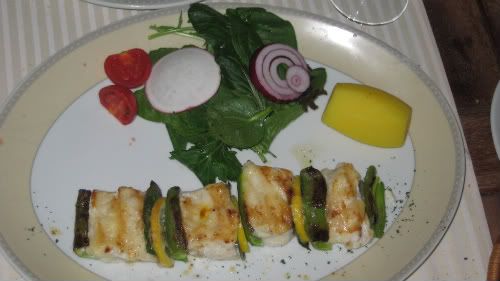
These were the stars of the show. The little mullets were crunchy and salty, perfect with a liberal squeeze of lemon juice. The şiş was juicy with a nice crust. To end the meal we ordered the local specialty, tahinli kabak tatlısı.
Pictured: Figs stuffed with walnuts and pumpkin with tahini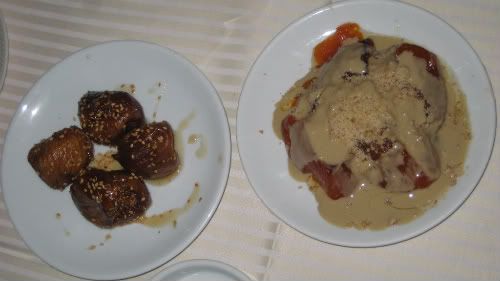
The pumpkin is cooked until soft then covered in syrup and a thin sesame paste. This particular dessert comes from the Antalya region so we saw it on a lot of menus. The dessert has a very unique flavor that is distinctly middle eastern, definitely worth trying.
http://www.antalyabalikevi.com.tr/
Şişçi Ramazan’ın Yeri
Pictured: Şiş köfte
Pictured: Tahinli Piyaz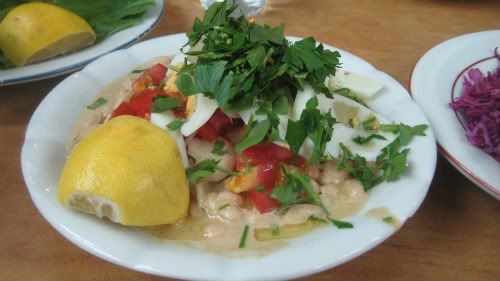
Şişçi Ramazan’ın Yeri is an old school kebab joint that specializes in şiş köfte which is skewered ground meat cooked over coals. The köfte at Şişçi Ramazan’ın Yeri are made from a mixture of goat and lamb meat to give a particularly gamey flavor and chewy texture. Nearly every table had an order or two of köfte, and I can understand why. While the köfte were great, the iskender kebap we ordered was pretty lackluster. Dry meat, underseasoned, really disappointing next to the stellar köfte.
As a side dish we ordered another regional specialty called tahinli piyaz. Similar to the dessert above, the sesame paste is made somewhat soupy and poured over stewed white beans. This combination worked remarkably well particularly with the large leaves of parsley that were liberally sprinkled on top. They also serve tahinli kabak tatlisi, but on this night we had our sights set on another local specialty.
Yener Ulusoy Bulvarı No:44/F
Antalya (no reservations)
Akdeniz Dondurma
Our final stop in Antalya was at the famous ice cream shop you see all over town. They have a number of different desserts on display when you walk in, and they're all pretty good, but the real draw is the burnt ice cream (yanık dondurma). It looks like regular vanilla ice cream (though stretchier than American ice cream as Turkish ice cream tends to be) with a distinct flavor of burnt caramel. When you order be sure to specify
yanık (yuh-nuk) because they have a number of flavors.
http://www.akdenizdondurma.com.tr/
Pictured: Coffeeshop in Antalya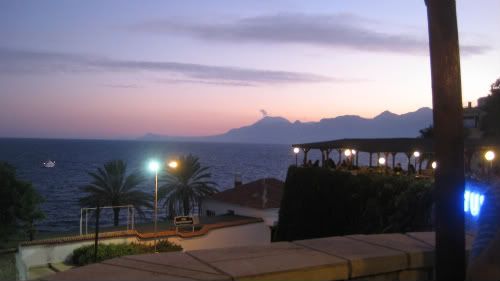
No trip to Antalya would be complete without sipping tea or Turkish coffee at one of the waterfront shops in Konyaaltı. The drinks are nothing special (if they have it try and order the orchid root drink called sahlep), but the manzara is truly special.Last edited by turkob on February 11th, 2011, 7:03 am, edited 1 time in total.
-
-
Post #30 - January 27th, 2011, 2:06 pmLast stop of the trip was in Kapadokya (Cappadocia).
Pictured: Houses carved out of the landforms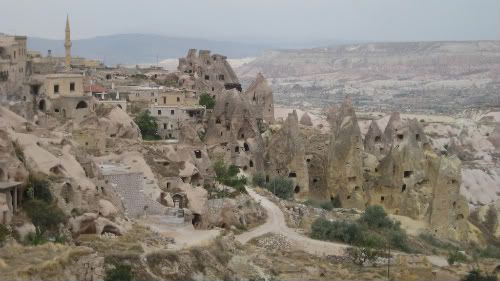
Unlike Antalya where it was possible to get away from the tourist traps, Kapadokya is a very tourist-focused region, with good reason since the sights are really unique and interesting. However to get great Turkish food you have to get out of Kapadokya to either of the nearby cities Nevşehir or Kayseri. Nonetheless we did the best we could in the region, though we did make it out for a couple meals.
Nazar Börek, Göreme
Pictured: Sosyete börek with spinach and feta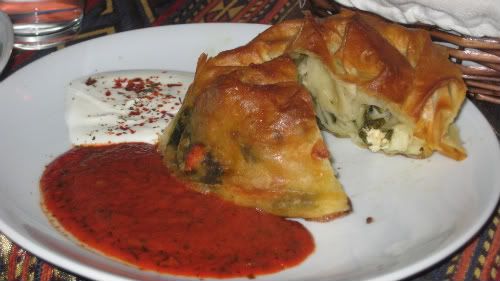
Sosyete börek is made by rolling the stuffing in fresh phyllo dough so it comes out more doughy and less crispy. Nazar Börek does a nice rendition that highlights the textural contrast between the outer layer and the chewy insides. The place is run by a nice, elderly couple who sit in front of the restaurant hailing guests and munching on pistachio nuts. The mezes and gözlemes were bland and uninteresting, but the börek wasn't half bad.
Couldn't find an address, but it's on the one road in town.
Ziggy's Cafe, Ürgüp
Pictured: Meze assortment
Ziggy's was written up in the New York Times and it has a huge number of positive reviews on Trip Advisor, so we figured we'd give it a shot. It's a nice space with luxurious seating and a very cozy feel. They don't have a selection of meze to choose from, instead you order the meze platter which comes with an assortment of meze made with what's in season. The meze definitely featured fresh ingredients, but for the most part they tasted safe and uninteresting. After the meze came the entrees which were western style meats. The steak was topped with a strange tomato sauce that couldn't be further from Turkish cuisine and the chicken, while skewered like a kebab, had almost no spice or char. Also, Ziggy's was the only time on the entire trip that I was startled by how expensive the food was. I understand why people like it, but it wasn't for us.
http://www.ziggycafe.com/
Dayı'nın Yeri, Avanos
Pictured: Kaşarlı Pide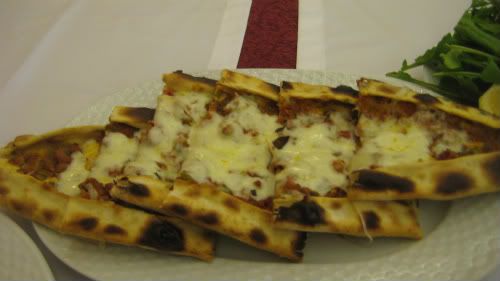
Avanos is fun little town that is famous for its pottery (and store owners who call you off the street to watch a pottery demonstration). I was surprised to see so many little restaurants selling Turkish specialties like işkembe çorbası (tripe soup), kelle (sheep's head), and paça çorbası (trotters soup). Sadly, they were all closed the day we visited, so we didn't get to try any, but if I were ever back in the area, my first stop for a mid-day meal would be Avanos. Nonetheless, we had a recommendation from our hotel owner for a kebab shop in the middle of town.
When we walked in we could smell the coals and the grilled lamb coming from the large grill in the middle of the room, a very very good sign. The waiter recommended we try one of their pides so we got one with ground meat and kashkeval cheese (kaşar peyniri). The pide had excellent char on the bread and the cheese was nice and gooey. Afterward we ordered a couple kebabs that were being cooked on the grill in the middle of the room. Nice char, lots of spices, good kebabs all around. From our limited experience, Avanos seemed like the place to get food in the area. Too bad we discovered it on our last day.
http://www.dayininyeri.com.tr/AnaSayfa-EN.aspx
Ihlara Valley
Pictured: Small shop specializing in gözleme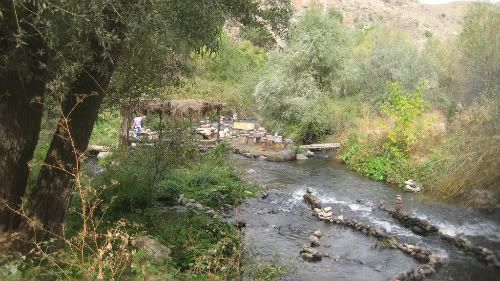
Pictured: Stock footage of gözleme being made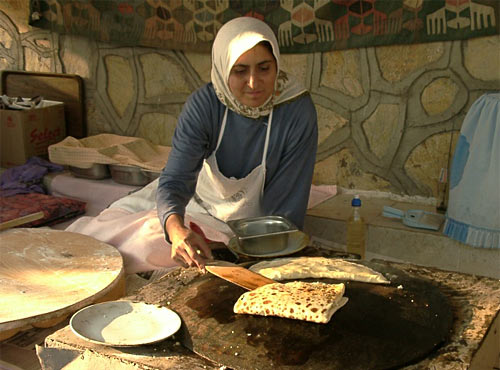
If you're taking a trip to Kapadokya, you're likely to take a hike through the Ihlara Valley. As we were hiking through the valley we saw a little shop built on top of the river. Naturally our expectations were low, but we were hungry and could use a break, so we found a seat at one of the tables surrounded by the river and ordered some tea and gözleme. Gözleme is made from a thin dough that is stuffed with cheese or meat and cooked on a griddle, similar to a quesadilla. There are gözleme shops all along the highways where you can stop and watch an old Turkish lady roll out the dough and cook it on a traditional rounded griddle. Surprisingly the gözleme we had in Ihlara Valley was very good. The dough was rolled thin so it was crispy and the cheese was just right. Avoid gözleme that has been premade and reheated. It's not hard to find gözleme that is rolled to order, apparently you can even get good gözleme on a hiking trail in the middle of nowhere.
The capital of the region is a small city called Nevşehir. There's not much to see in the city itself, but after two nights in the heart of Kapadokya we decided to head into the city to do some shopping and get away from all the tourists.
In the center of town is a large shopping complex called the Kapadokya Forum, complete with a movie theater, a Gap, and a food court. After a couple hours of walking around in the shopping center we headed up to the food court for dinner. They have some typical western options like McDonald's and Pizza Hut, but our eyes immediately gravitated towards the kebab shop in the corner.
TNR İskender
Pictured: İskender Kebabı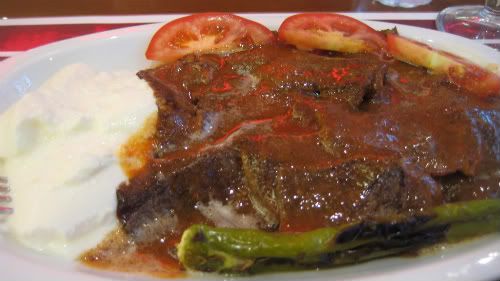
It's a surprisingly nice restaurant for a food court with lots of tables and good service. The place was packed and they were pumping out plate after plate of İskender. The dish is named after its creator (the name is a form of the name Alexander) who owned a famous kebab shop in Bursa in the late 19th century. A great İskender kebab will have thinly shaved slices of meat, each well browned, on top of fresh pita bread, covered in hot tomato sauce and sizzling butter served at the table, with a side of thick yogurt. If you only eat one kebab in Turkey, this is the one to get. Lots of places offer this dish, but be sure to go to a place that specializes in İskender, it makes a big difference. TNR nailed it on all fronts.
I couldn't find the address of the shopping mall, but it's called Kapadokya Forum. It's the biggest mall in town.
Mado
Pictured: Baklava assortment and orchid root ice cream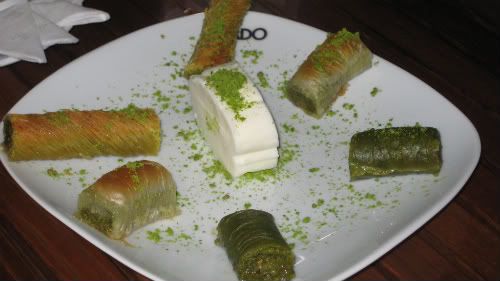
After the great kebabs in the mall we were on the look out for dessert. The dessert shops in the food court didn't look that appetizing so we decided to try our luck looking around town. Across the street from the mall, in a BP gas station, is a Mado. Jackpot! This gas station version of Mado had much less ambiance than other Mados, but the desserts were every bit as good. We ordered a mix plate of baklavas and a nice thick slice of maraş dondurma, Mado's speciality. The baklavas are top notch, but my absolute favorite are the green ones that are made with thinner dough and stuffed with tons of pistachio nuts. Maraş dondurma (hence the name Mado) is made from orchid root so its much thicker and stretchy. It has a pleasant, though mild flavor, but the texture is wonderful, particularly when paired with crunchy, nutty baklavas. You can find maraş dondurma in tourist areas being served by guys performing tricks with the thick ice cream. Be careful, they don't just play tricks with the ice cream, more than once they tried to overcharge me or give me two when I asked for one. Plus the ice cream from those types of places isn't as good. For the real deal, head to Mado (or better yet Kahramanmaraş province where orchid root is the local delicacy).
Üstad Necip Fazıl Kısakürek Bulvarı No:23
Nevşehir (in the BP station)
Nevşehir is a nice escape from the tourist crush in Kapadokya, but for a top notch Turkish experience, Kayseri is the spot. Most people fly in and out of Kayseri on their way to Kapadokya, but many ignore it. It's about an hour from Kayseri to the main tourist cities of Göreme and Ürgüp, so it's not realistic to stay there, but definitely leave time before or after (or both as we did) to sample some of the local cuisine.
Pictured: Butcher shop in Kayseri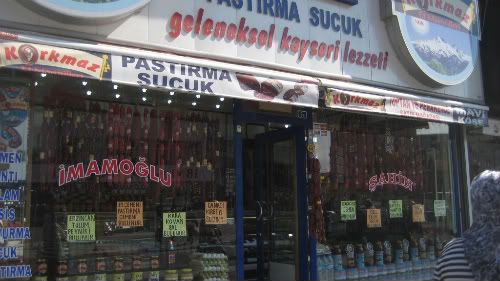
As soon as you get into downtown, you can tell that Kayseri is known throughout Turkey for its butcher shops. Hanging in the window are all kinds of pastırma, air-cured meat, and sucuk, spicy sausage. You can smell the wonderfully spicy, funky meat from down the street. We bought some pastırma as a gift for some family and the entire bag smelled for weeks afterward. This is potent stuff.
Pictured: Ekmek Kadayıfı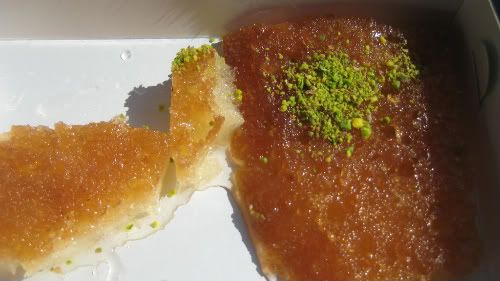
The region is also famous for the quality of its wheat. All over town are shops making sandwiches in dürüm wraps and the most famous local specialty is mantı. As we were walking down main street we saw a dessert shop with huge trays of ekmek kadayıfı which is a dessert made with bread cooked in syrup. It's made with a particularly spongy bread that soaks up the syrup and gets chewy on the bottom where it caramelizes (the best part of course). Traditionally it is topped with clotted cream.
Kaşık-la
Pictured: Entrance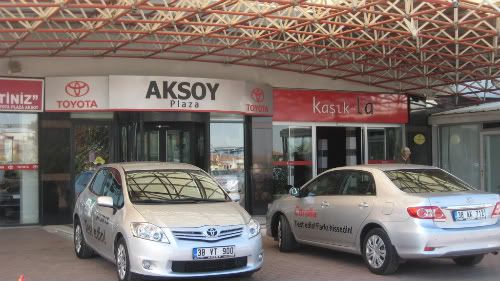
Kaşık-la is perhaps the most famous spot in Kayseri for mantı. The name means "with a spoon" which is how they recommend you eat the mantı. It was remarkably easy to find because it's located next to a Toyota dealership. And by next to I mean they share a building and the parking lot is filled with new cars. When you walk in they have pictures of all their specialties hanging on the wall, which makes it pretty easy to order.
Pictured: Mantı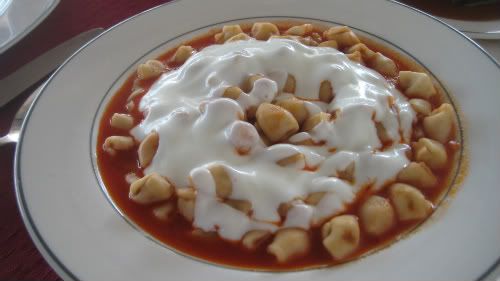
We ordered a bunch of different dishes from their yöresel menu which means local specialties, and everything was great, but the mantı really stood out above the rest. Kayseri style mantı is made with a thicker dough so that's it's still chewy after it's boiled. While mantı is always served with garlic yogurt, Kaşık-la went one step further bringing a side of crushed garlic so you can make it as garlicky as you want. We liked it so much we came back our last day in town to get another bowl of that mantı.
Pictured: Kiremitte Pastırma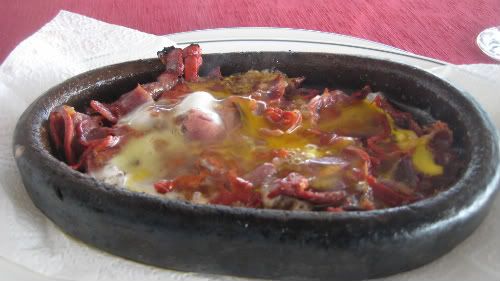
Our second trip was in the morning, so I had to order a classic breakfast dish, pastırma cooked in a clay bowl topped with a runny egg. Oh man. The pastırma is seriously spicy, I could taste it for the rest of the day. When baked in the clay bowl the edges get crispy and the aroma becomes even more intense. This is a pastırma lovers paradise.
Kaşık-la
Zafer Caddesi No: 4
Kayseri
http://www.kasikla.com/

